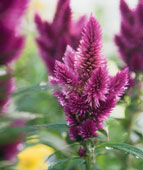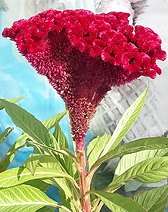growing celosia for beginners
HomeAnnuals
More Annuals
Perennials
Tips and Links
Gardening Terms
Gardening Links
Sitemap
Plant Doctor Blog
Vegetables
Tomatoes
Beans & Corn
Fall Salad Garden
Going Green
Starting a Garden
Lawn Care
Spring Bulbs
Summer Bulbs
House Plants
Plants in Containers Groundcovers
Growing Roses
Compost
Manure Tea
Frost Dates
Hardiness Zones
Winter Annuals
Please click on Google ads to support this site.
Please click on Google ads to support this site.

Gardening for beginners, celosia for beginners
(Cockscomb)
| A real eye catcher, celosia is a brilliantly colored addition
to any sunny garden. There are two types, one type has feathery flowers (like
the picture) and the other has blooms that are shaped like a rooster's {or cock's) crest.
Some varieties of celosia grow only 10 inches tall while some reach
three feet. The plants like plenty of sun and a well drained soil. Celosia grows with a moderate amount of watering. Fertilizing every six weeks with liquid fertilizer or manure tea is helpful.
In addition to its bright colors, celosias adds interesting textures and structures to the flower bed. The taller varieties give a vertical accent to the middle or rear of the bed. The plumosa or feathery type provide a contrast to more common flower types such as a petunia's trumpet shape or the daisy shape of a zinnia. The crested cockscomb is an interesting structure in itself.
The plants can be started from seeds, but six packs are commonly available in the spring. Butterflies are attracted to celosia.
The flower heads are beautiful but lose their attractiveness as they go to
seed. It is best to remove the stem at that time. Celosias are sometimes infected with aphids. Grasshoppers and caterpillars sometimes eat them. Celosia makes striking bouquets of cut flowers and can be dried for floral arrangements. To dry, cut the stems near the ground when they are in full bloom, remove the leaves, and hang upside down in a dark, dry spot in the garage or shed. Hang them far enough apart so the stems or flower heads do not touch and place an old sheet below them to catch any seeds that might fall from the blooms. Celosia |

Celosia Links:
|
